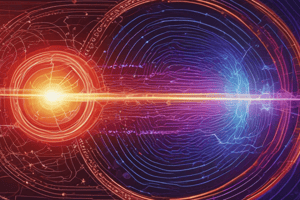Podcast
Questions and Answers
Electromagnetic induction is change in
Electromagnetic induction is change in
- electric field
- magnetic poles
- surface area
- magnetic flux (correct)
What would happen if I move a bar magnet in and out of a coil of copper wire?
What would happen if I move a bar magnet in and out of a coil of copper wire?
- It would produce a gravitational field
- Electric current will flow through the wire (correct)
- The magnet would explode
- Electric current would disappear
_____ law says that the Induced current is proportional to the change of magnetic flux.
_____ law says that the Induced current is proportional to the change of magnetic flux.
Faraday's
Where is the strongest attraction force of the magnet?
Where is the strongest attraction force of the magnet?
What type of current is produced by a battery?
What type of current is produced by a battery?
What creates a magnetic field?
What creates a magnetic field?
Voltage can be induced in a wire by
Voltage can be induced in a wire by
A magnet can move in a coil of wire to produce electricity in which system?
A magnet can move in a coil of wire to produce electricity in which system?
Magnetic Field lines around a bar magnet
Magnetic Field lines around a bar magnet
How do Maglev trains go up to 311 MPH?
How do Maglev trains go up to 311 MPH?
Flashcards
Electromagnetic Induction
Electromagnetic Induction
The phenomenon where a changing magnetic flux through a circuit induces an electromotive force (EMF) and a current in the circuit.
Magnetic Flux (ΦB)
Magnetic Flux (ΦB)
The measure of the amount of magnetic field lines passing through a surface. It's calculated as ΦB = B⋅A = BA cos θ, where B is the magnetic field, A is the area, and θ is the angle between B and the normal to A.
Faraday's Law of Induction
Faraday's Law of Induction
The law states that the induced EMF in a closed loop equals the negative of the time rate of change of magnetic flux through the loop, mathematically expressed as E = -dΦB/dt.
Lenz's Law
Lenz's Law
Signup and view all the flashcards
Electromagnetic Induction
Electromagnetic Induction
Signup and view all the flashcards
Magnitude of Induced EMF
Magnitude of Induced EMF
Signup and view all the flashcards
Induced Electric Field
Induced Electric Field
Signup and view all the flashcards
Non-Electrostatic/Induced Electric Field
Non-Electrostatic/Induced Electric Field
Signup and view all the flashcards
Faraday's Law Applications
Faraday's Law Applications
Signup and view all the flashcards
Factors Affecting Induced Voltage
Factors Affecting Induced Voltage
Signup and view all the flashcards
Study Notes
Introduction to Magnetic Induction and Faraday's Law
- Electric circuits are essential in modern devices, requiring an electromotive force (EMF) for current flow.
- Electric generating stations produce EMF, converting energy such as gravitational potential, chemical, or nuclear energy.
- Electromagnetic induction describes when a changing magnetic flux induces EMF and current in a circuit.
- Transformers depend on magnetically induced EMFs.
- Faraday's law relates induced EMF to changing magnetic flux in any loop, including closed circuits.
Induction Experiments
- Michael Faraday and Joseph Henry conducted pioneering experiments on magnetically induced EMF in the 1830s.
- Key observations from experiments with coils and magnets include:
- A stationary magnet near a coil shows no current.
- Moving a magnet toward or away from the coil induces current.
- Moving the coil instead of the magnet also induces current.
- Replacing the magnet with a second coil connected to a battery induces current only when one coil is moving relative to the other.
- Varying the current in one coil (by opening/closing the switch or changing resistance) induces current in a nearby stationary coil.
- Induced current refers to the current generated this way, and induced EMF is the electromotive force required to cause it.
- Changing magnetic flux is the common element in these experiments.
- Induced EMF is proportional to the rate of change of magnetic flux; its direction depends on whether the flux is increasing or decreasing.
- Induced EMFs have practical applications such as electric generators, and wall sockets.
Magnetic Flux
- Magnetic flux (Φ or ΦB) describes the component of the magnetic field passing through a surface.
- It's proportional to the number of field lines through the surface.
- The magnetic flux through a surface of vector area A is ΦB = B ⋅ A = BA cosθ, where:
- B is the magnetic field magnitude in Tesla (T).
- A is the area of the surface.
- θ is the angle between magnetic field lines and the normal (perpendicular) to A.
- The SI unit for magnetic flux is the tesla-square meter (T⋅m²), also known as the weber (Wb) where 1 Wb = 1 T⋅m².
Faraday's Law
- It states that the induced EMF in a closed loop is equal to the negative of the time rate of change of magnetic flux through the loop.
- In symbols, Faraday's law is written as ε = -dΦB/dt.
- The induced EMF opposes the flux change.
- If the magnetic flux changes through a coil of N turns, the total induced EMF is ε = -N(dΦB/dt).
- Change the magnetic flux through a coil by:
- Change the magnitude B of the magnetic field within the coil.
- Alter the total area of the coil or the portion within the magnetic field.
- Change the angle between the magnetic field direction and the plane of the coil.
Example: EMF and Current Induced in a Loop
- Consider a uniform magnetic field that is increasing at a rate of 0.020 T/s, passing through a conducting loop of 120 cm² area and 5.0 Ω resistance.
- To find the induced EMF and current, calculate the magnetic flux ΦB = BA, then use Faraday's law to find ε, and Ohm's law (ε = IR) to find I.
- Replacing a conducting loop with an insulator doesn't change the induced EMF.
- The current will be smaller; if the loop is a perfect insulator, the induced current is zero.
Direction of Induced EMF
- To find the direction of an induced EMF or current:
- Define a positive direction for the vector area 𝐴.
- Determine the sign of the magnetic flux ΦB and its rate of change based on the directions of 𝐴 and the magnetic field 𝐵.
- Determine the sign of the induced EMF or current: If the flux is increasing, the induced EMF/current is negative; if decreasing, the induced EMF/current is positive.
- Use the right-hand rule to find the direction of the induced EMF or current.
Lenz's Law
- Lenz's law states that any induction effect tends to oppose the change that caused it.
- It's a manifestation of the conservation of energy.
- Electromagnetic induction can be used to produce voltage using magnetic fields, generating current in a closed circuit.
- Factors determining the induced EMF:
- Increase the number of wire turns in the coil to increase the induced EMF.
- Increase the relative speed between the coil and magnet to increase the induced EMF.
- Increase the strength of the magnetic field for greater EMF.
Applications of Faraday's Law
- Faraday's law has applications:
- Electrical equipment like transformers.
- Induction cookers.
- Electromagnetic flowmeters.
- Electric guitars and violins.
- Maxwell's equation
Example: Magnitude and Direction of an Induced EMF
- A 500-loop coil with a 4.00 cm radius is placed in a magnetic field decreasing at 0.200 T/s:
- Calculating the induced EMF using Faraday's law: ε = N(dB/dt)Acosθ.
- The direction of the induced EMF follows the right-hand rule.
Induced Electric Field
- A changing magnetic flux results in an induced EMF.
- Faraday's law states that induced EMF is the negative rate of change of magnetic flux.
- If it changes over time, it has to be an induced EMF, then charges can move and produce a current.
- This current is referred to as an induced current.
- An induced electric field makes the charges move.
- This induced electric field is non-electrostatic, they go around in loops, appearing when a magnetic flux is present, and disappear when there is no change.
- The induced electric field is nonconservative.
Studying That Suits You
Use AI to generate personalized quizzes and flashcards to suit your learning preferences.




